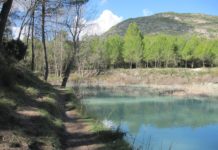With the problems of ecological damage in the Mar Menor still not resolving as quickly as environmentalists might hope, the Spanish Government has published a tender for the creation of a network of sensors to gather information in real-time in six areas of the coastal lagoon.
The 1.49-million-euro tender includes the purchase and installation of a monitoring network with buoys, sensors, seamounts, weather stations or current profilers, capable of issuing continuous and real-time information on the state of its waters.
To date, the monitoring of the Mar Menor was done with specific samplings carried out from boats that do not allow detection of live knowledge of physical-chemical and biological anomalies, related to the different symptoms of the eutrophication process that are critical for the state of the ecosystem and its recovery, such as phytoplankton proliferations and harmful species, anoxia phenomena, light limitation, heat waves or microbial activity.
There is also a buoy located by the Smart Lagoon project, financed by the EU, and which will be integrated into the oceanographic observation infrastructure of the state of the lagoon and the dynamics of exchange with the Mediterranean Sea, carried out by the Spanish Institute of Oceanography (IEO), a state body that will also manage the new network that has been put out to tender.
The new system is included in the Framework of Priority Actions to Recover the Mar Menor (MAPMM), endowed with 484.4 million, and which dedicates 15 million to the line of improvement of knowledge and monitoring.
The locations planned for this network will be the north and south basins, the central platform, the headquarters of the Spanish Institute of Oceanography in San Pedro del Pinatar and the golas of Estacio and Marchamalo.
All monitoring platforms will send the information from the sensors in real time through the GSM/GPRS system. This will allow downloading of historical data, generate automatic reports and grant access to third parties.
The contract also includes devoting 229,000 euro to spare parts for the stations, so that, if necessary, the buoy, the weather station, the multi-parameter probe, the current profiler or the seamount can be replaced.





